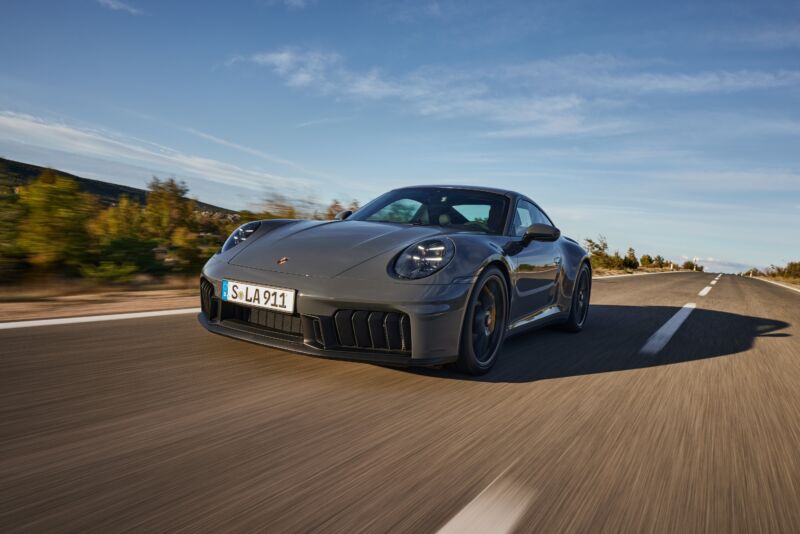3.6 L —
The iconic sports car gets an electrified option as part of the 992-generation refresh.

Enlarge / The current 911—known to Porschephiles as the 992 generation—has just been given its midlife refresh. The most obvious visual indicator is the presence of vertical strakes in the front air intakes. But we’re much more interested in what’s gone on under the skin.
Porsche
Today, Porsche gave the venerable 911 a bit of a spiff-up, putting an updated engine in the base 911 Carrera and making some design tweaks to keep the 992-generation machine looking fresh. But the most interesting update is an all-new powertrain in the 911 Carrera GTS. For the first time, you can now buy a hybrid 911.
When Porsche has been asked about adding electrification to the 911, the answer has generally been some variation of “we’ll do it when the technology gets light enough.” Plug-in hybrid Cayennes, Panameras, and battery electric Taycans are all well and good because they are big cars.
But a Porsche 911 remains a relatively small car, even if it has grown a little since 1963. The engine bay behind the rear axle isn’t exactly expansive, and adding a high-voltage battery and electric motors had to be done thoughtfully.
F1-style
There’s still a flat-six engine at the back—Porsche didn’t decide to downsize to the 718’s four-cylinder version to free up space. In fact, it increased the engine’s bore (to 97 mm) and stroke (to 81 mm) to increase the engine capacity to 3.6 L, up from 3.0 L in the previous 911 Carrera GTS. On its own, the six-cylinder turbocharged boxer engine generates a fraction more power and the same amount of torque as the old engine—478 hp (357 kW) and 420 lb-ft (570 Nm).
-
The GTS engine grows in capacity by 20 percent.
Porsche
-
I’m going to have to stop writing that F1 MGU-Hs have no road relevance now, because that’s what Porsche has fitted to the GTS’ turbocharger.
Porsche
-
This is the rear-wheel drive GTS powertrain. The traction battery is that silver box above the front axle.
Porsche
But it’s not on its own. And, like an F1 car—or perhaps the all-conquering Porsche 919 Hybrid endurance racer—it actually has a pair of hybrid systems. A permanently excited synchronous motor is integrated into the eight-speed PDK transmission, which generates 54 hp (40 kW) and 110 lb-ft (150 Nm) and can send power to the wheels, boosting or filling in gaps in the engine’s torque curve as well as regenerating energy under braking.
A second motor-generator unit is integrated into the engine’s single-scroll turbocharger. This is rated at just 11 kW, but it can spin up the turbine to create boost or harvest electrical energy from the exhaust gases, just like an MGU-H in F1.
Obviously, a hybrid needs a battery, and the 911 Carrera GTS’ high-voltage traction battery lives under the hood up front, where you’d normally find a 12 V battery for starting. The traction battery operates at 400 V and is about the same size and weight as a conventional AGM 12 V battery used in a 911, but it has a storage capacity of 1.9 kWh. There is still a 12 V battery for starting the car, but it’s now a compact lithium-ion battery that lives under the rear parcel shelf.
Working in concert, the hybrid powertrain has a combined rating of 532 hp (398 kW) and 449 lb-ft (609 Nm). And the weight penalty is just 103 lbs (47 kg) more than the old 911 Carrera GTS Coupe.
(Yes, technically, there has been a hybrid 911 before—the 911 GT3-R Hybrid race car, which we’ve written about a couple of times in the past. But it’s now a museum piece, and its flywheel hybrid system has been permanently deactivated.)
Rear seats are now optional
Interestingly, Porsche is now making the 911 a two-seater by default. However, you can still spec one with rear seats—best used by small children or pets and a little torturous for adults for any period of time—as a no-cost option. That applies to all 911s, not just the GTS.
The interior also gets the same 12.6-inch curved digital display in front of the driver as you’ll find in a Taycan or Panamera, replacing the old setup of two smaller digital displays on either side of a large physical tachometer.
-
There’s a new dashboard for model-year 2025 Porsche 911s.
Porsche
-
The GTS also comes in a Cabriolet.
-
And even a Targa, as long as you’re OK with all-wheel drive.
Porsche
-
A closer look at the new front air intakes.
Porsche
-
The changes at the rear are pretty subtle.
The 911 Carrera GTS is available in rear- or all-wheel drive and three body styles. Both RWD and AWD are available as either a coupe or convertible, and the AWD Carrera 4 GTS is also available with a retractable hard top (Targa). All come with the eight-speed PDK transmission, as there’s no option for a manual transmission with the new hybrid powertrain.
The GTS carries a hefty $44,800 premium over the entry-level 911 Carrera, however. The 911 Carrera GTS starts at $164,900, with the Carrera GTS Cabriolet starting at $178,200. An AWD Carrera 4 GTS will cost at least $172,700, and both the Carrera 4 GTS Cabriolet and Targa will start at $186,000. Porsche says the GTS is expected at the end of 2024.